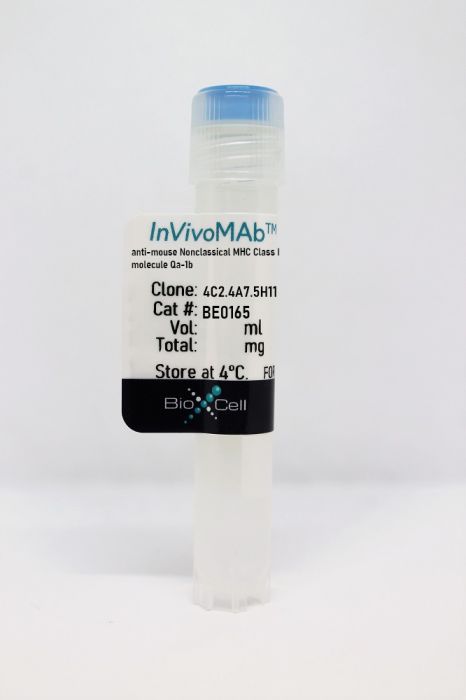InVivoMAb anti-mouse Nonclassical MHC Class I molecule Qa-1b
Product Details
The 4C2.4A7.5H11 monoclonal antibody reacts with the mouse non-classical MHC class I molecule Qa-1b. Qa-1b is the functional homolog of HLA-E in humans and is characterized by its limited polymorphisms and small peptide repertoire. Qa-1b interacts with NK cells through the CD94/NKG2 family of receptors. Upon binding, Qa-1b signals NK cells not to engage in cell lysis.Specifications
| Isotype | Mouse IgG1 |
|---|---|
| Recommended Isotype Control(s) | InVivoMAb mouse IgG1 isotype control, unknown specificity |
| Recommended Dilution Buffer | InVivoPure pH 7.0 Dilution Buffer |
| Conjugation | This product is unconjugated. Conjugation is available via our Antibody Conjugation Services. |
| Immunogen | Peptide corresponding to residues 161-179 of Qa-1b |
| Reported Applications |
Western blot Immunofluorescence |
| Formulation |
PBS, pH 7.0 Contains no stabilizers or preservatives |
| Endotoxin |
<2EU/mg (<0.002EU/μg) Determined by LAL gel clotting assay |
| Purity |
>95% Determined by SDS-PAGE |
| Sterility | 0.2 µm filtration |
| Production | Purified from cell culture supernatant in an animal-free facility |
| Purification | Protein A |
| RRID | AB_10949623 |
| Molecular Weight | 150 kDa |
| Storage | The antibody solution should be stored at the stock concentration at 4°C. Do not freeze. |
Recommended Products
Western Blot
Davies, A., et al. (2004). "Infection-induced expansion of a MHC Class Ib-dependent intestinal intraepithelial gammadelta T cell subset" J Immunol 172(11): 6828-6837. PubMed
Salmonella species invade the host via the intestinal epithelium. Hence, intestinal intraepithelial lymphocytes (iIELs) are potentially the first element of the immune system to encounter Salmonella during infection. In this study, we demonstrate, in a mouse model, the expansion of a CD8alphabeta(+)CD94(-)TCRgammadelta(+) T cell subset within the iIEL population in response to oral infection with virulent or avirulent Salmonella. This population can be detected 3 days following infection, represents up to 15% of the TCRgammadelta(+) iIELs, and is dependent on the MHC class Ib molecule T23 (Qa-1). Qa-1 is expressed by intestinal epithelial cells and thus accessible for iIEL recognition. Such cells may play a role in the early immune response to Salmonella.
Immunofluorescence
Gays, F., et al. (2001). "Functional analysis of the molecular factors controlling Qa1-mediated protection of target cells from NK lysis" J Immunol 166(3): 1601-1610. PubMed
CD94/NKG2 receptors on mouse NK cells recognize the nonclassical class I molecule Qa1 and can deliver inhibitory signals that prevent NK cells from lysing Qa1-expressing cells. However, the exact circumstances under which Qa1 protects cells from NK lysis and, in particular, the role of the dominant Qa1-associated peptide, Qdm, are unclear. In this study, we examined in detail the lysis of Qa1-expressing cells by fetal NK cells that express CD94/NKG2 receptors for Qa1 but that lack receptors for classical class I molecules. Whereas mouse L cells and human C1R cells transfected with Qa1 were resistant to lysis by these effectors, Qa1-transfected TAP-deficient human T2 cells showed no resistance despite expressing high levels of surface Qa1. However, these cells could be efficiently protected by exposure to low concentrations of Qdm peptide or certain Qdm-related peptides. By contrast, even prolonged exposure of TAP-deficient RMA/S cells to high doses of Qdm peptide failed to induce levels of surface Qa1 detectable with a Qa1-specific mAb or to protect them from NK lysis, although such treatment induced sensitivity to lysis by Qa1-specific CTL. Collectively, these findings indicate that high surface expression of Qa1 is necessary but not sufficient for protection, and that effective protection requires the expression of sufficient levels of suitable Qa1-peptide complexes to overcome activatory signals. Results obtained with a series of substituted Qdm peptides suggest that residues at positions 3, 4, 5, and 8 of the Qdm sequence, AMAPRTLLL, are important for recognition of Qa1-Qdm complexes by inhibitory CD94/NKG2 receptors.



